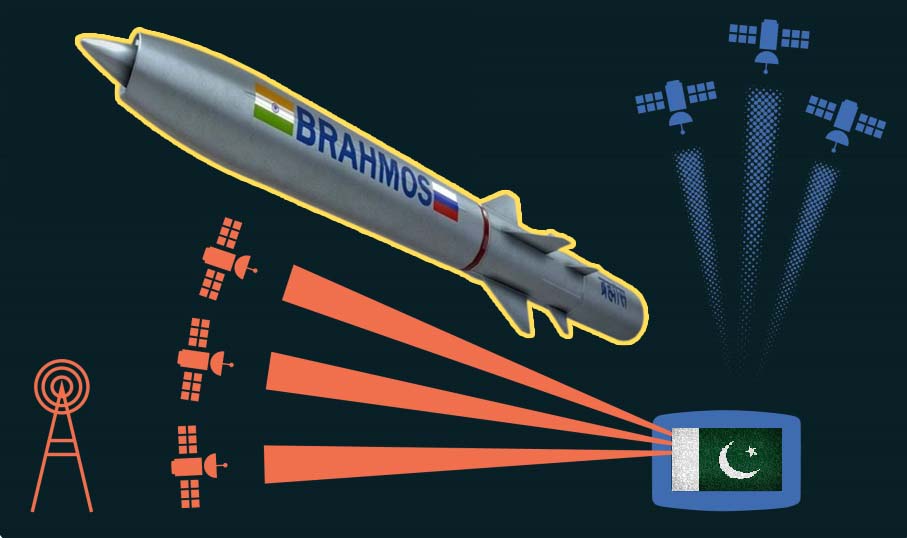
- At Mach 3, BrahMos is a blur, covering 1 km per second and a range extending to 450 km.
- BrahMos pairs a rock-solid Inertial Navigation System (INS) with Global GPS/GNSS, Russia’s GLONASS, GAGAN, and Navic.
- In the last 20-30 km, BrahMos’s radar seeker takes charge, making GPS spoofing irrelevant and hits the target in Fire and Forget mode.
- BrahMos’s ability to strike with unmatched precision, dodge interception, and spoofing-proof ability, threatens Pakistan’s naval bases and command hubs.
Imagine a missile tearing through the sky at three times the speed of sound, skimming just above the waves, and hitting a target with the precision of a sniper. Imagine a disgruntled clown claiming to intercept it with third-grade defence systems, received as alms. That missile is BrahMos, India’s supersonic marvel, co-crafted with Russia. Clocking Mach 3 (3,700 km/h), with a minimal 1-meter Circular Error Probable (CEP), it’s a nightmare for any defence system, where Pakistan’s Chinese toys are not even a contender, forget interception. Its speed, stealth, and smart manoeuvres make it untouchable, shrugging off crazy claims like interception and GPS spoofing. And the clown being the centre of Gravity of the Pakistani Army, Air Vice Marshal Aurangzeb Ahmed, apparently a two-star rank officer who is the current Director General Public Relations of the Pakistan Air Force. The claims of interception of the same missile that hit at 12 Air bases in under 23 minutes and allegedly crippled Pakistan’s nuclear installations, can be a cope tonic for its delusional masses, but doesn’t withstand the logical scrutiny. Here’s why Pakistan’s air defences and electronic tricks don’t stand a chance against Brahmos, broken down into undeniable truths.
1. Pakistan’s Centre of Gravity: Outlandish claims
On May 11, 2025, a claim by Pakistan’s Air Vice Marshal Aurangzeb sparked controversy when Aurangzeb demonstrated the diversion of BrahMos missiles using GPS spoofing or electronic warfare during alleged strikes on May 7, 2025. But while abeyance of IWT (Indus Water Treaty) brings a water shortage in Pakistan’s general populace, it seems there is also an abundant shortage of intelligence quotient within the Pakistani Military. Not only can Brahmos not be intercepted, but it cannot be soft-kill by any dreamy means of the Pakistani Army.
2. Speed That Leaves Defenders Breathless: Mach 3
Headquartered in New Delhi, Brahmos Aerospace was established as a joint venture between India’s Defence Research and Development Organisation and NPO Mashinostroyeniya of Russia. At Mach 3, BrahMos is a blur, covering 1 km per second and a range extending to 450 km. A 200-km strike takes just 3.3 minutes. What shall happen if BrahMos decides to hit a target? Pure Carnage.
Pakistan’s top-tier HQ-9B, a Chinese import with a 200-km range, needs to detect, track, and fire in seconds. But its YLC-2V radar spots low-flying targets only at 20-30 km, thanks to Earth’s curve. That’s under 20 seconds to react, barely enough to blink, let alone launch. In a 2013 test off Goa, BrahMos nailed a naval target 290 km away in under 5 minutes, performing a high-level C-manoeuvre and leaving simulated defences scrambling. The HQ-9B’s 5-10 second launch cycle can’t keep up with a missile that’s already gone.
3. Flying Low, Staying Hidden: Deception warfare
BrahMos flies as low as 5 meters above water and 10 meters above land, showing a huge range of sea-skimming and terrain-hugging profiles, exploiting radar blind spots and vanishing into the radar clutter. Pakistan’s Saab 2000 Erieye, though great for spotting jets, struggles with sea-skimming targets due to limited look-down resolution in 30-degree sectors. In a 2021 Andaman test, BrahMos flew 10 meters above water, undetected by coastal radars until 15 km out. Pakistan’s LY-80 (HQ-16, 70-km range) and FM-90 ( HQ-7B, 15-km range) are blind to such low flyers until it’s too late. With a 1-meter CEP, BrahMos could take out Karachi’s beloved radar dish and serve it cold, before defenders even know it’s coming.
4. Dodging Bullets with Swagger: The Stealth Brahamstra
In its final sprint, BrahMos pulls high-G “S-manoeuvres,” zigzagging like a hawk. This throws off SAMS like the HQ-9B, which needs a steady target. It’s an X-band radar seeker, packed with anti-jamming tech, that locks on despite Pakistan’s electronic noise. In best performances, BrahMos can hit a land target with 0.8-meter pinpoint accuracy, even under simulated jamming. The FM-90’s 6 to 8-second reaction time is useless against a missile closing at 1 km/s, ensuring it smashes fortified targets like Noor Khan Air base with surgical precision.
5. GPS Spoofing Counter-measures Hybrid Navigation
India’s pursuit of an indigenous satellite navigation system was catalysed by a pivotal moment during the 1999 Kargil War, when the U.S. restricted India’s access to GPS data. This denial critically hampered Indian military operations during the conflict, as troops struggled to navigate and target entrenched Pakistani forces in the Himalayas’ treacherous terrain. The experience exposed India’s vulnerability to external technological dependencies, prompting a decisive shift toward self-reliance.
The GPS Aided Geo Augmented Navigation (GAGAN), developed jointly by the Indian Space Research Organisation (ISRO) and the Airports Authority of India (AAI), is a cutting-edge Regional Satellite-Based Augmentation System (SBAS). Designed to elevate the safety and efficiency of civil aviation, GAGAN enhances standard GPS signals to deliver meter-level accuracy, ensuring reliable navigation across India’s airspace and neighbouring regions. Operational since 2015, it positions India among an elite group of nations, including the U.S. (WAAS) and EU (EGNOS), with indigenous SBAS capabilities. By 2018, India operationalised its Navigation with Indian Constellation (Navic), a $350 million indigenous satellite network providing regional coverage with military-grade accuracy and high-tech encryption. Today, Navic not only safeguards India’s strategic autonomy but also underpins critical systems like the BrahMos missile, ensuring immunity to foreign GPS disruptions.
What is GPS Spoofing? Spoofing involves broadcasting fake GPS signals to deceive a receiver into calculating an incorrect position, potentially causing a missile to deviate from its intended path. Unlike jamming, which disrupts signals, spoofing is more insidious as it can go undetected without proper countermeasures.
BrahMos pairs a rock-solid Inertial Navigation System (INS) with Global GPS/GNSS, Russia’s GLONASS, GAGAN, and Navic. The INS, using Ring Laser Gyroscopes, doesn’t care about spoofed signals, drifting just 0.1-0.5 meters per minute. Spoofing all four satellite systems at once, no system in the world can do it. Atop are the Pakistani outlandish claims of satellite hacking; then again, to hack two Asian superpowers, India and Russia, at the same time is just not a possibility. Pakistan’s EW radars, which are even ineffective against Kamikaze drones, lack the juice for military-grade receivers with encryption. Even if we presume a scenario where spoofing kicks in at 3 Machs while guided by SatNavs like GLONASS, INS immediately shall take over, shifting it to Navic or GAGAN and vice versa, thus keeping that 1-meter CEP tight.
6. Radar Lock That Ignores Tricks: Fire and Forget
Fire-and-forget is an advanced missile guidance technology that enables a weapon to autonomously track and engage its target without requiring further input from the launch platform after deployment. Unlike semi-active systems (e.g., laser-guided bombs) or command-guided missiles (e.g., wire-controlled anti-tank weapons), fire-and-forget missiles rely on self-contained seekers and onboard computing to navigate, leaving operators free to reposition or engage other threats immediately after launch.
In the last 20-30 km, BrahMos’s radar seeker takes charge, making GPS spoofing irrelevant and hits the target in Fire and Forget mode. It homes in using radio waves, unfazed by Pakistan’s EW radars. For Brahmos, destroying a moving vessel with 0.9-meter precision, despite heavy jamming, is a piece of cake. The seeker’s anti-jamming tech laughs off interference. With a 4-minute flight time for 200 km, spoofing has no window to work. Even if Satellite Navigation wobbles, INS bridges the gap until radar kicks in, guaranteeing a bullseye on high-value targets.
7. India’s Strategic Edge
Pakistan’s defence budget in 2024 was $7.8 billion, dwarfed by India’s $81.2 billion, limiting upgrades to systems like the HQ-9B (4-8 launchers per battery). A single Su-30 MKI squadron, carrying 12 BrahMos missiles, could overwhelm this, as each HQ-9B can engage only 4-6 targets simultaneously. BrahMos’s 1-meter CEP, validated in continuous tests from 2019–2024, ensures 50% of strikes land within a meter, compared to Pakistan’s older SAMS with humongous 10- 20-meter CEPS. As per DRDO, BrahMos’s INS drift is as low as 0.2 meters per minute, negligible for its 5-minute flights. Pakistan’s EW failed against Indian Air Force strikes badly, highlighting its limits against BrahMos’s desi G3OM receiver, a first time for any missile in the world, providing hit accuracy even below a height of 5 metres.
BrahMos rewrites the rules in the Aerial combat, with 15 countries eagerly lining up to include the missile in their Armada. Its ability to strike with unmatched precision, dodge interception, and spoofing-proof ability, threatens Pakistan’s naval bases and command hubs. As hypersonic variants like Brahmos-II with a range of 450 kms, Brahmos-NG, a lighter version of doom, hovers over Pakistan’s defences in future, that is already beaten, bruised and battered, making an invincible impossible challenge. The question must be asked about the fraudulent claims of the Pakistani Air Marshal. If indeed you can intercept a BrahMos, how did it hit 12 most secure air bases of Pakistan in less than 23 minutes?
The Dog-fight that took place, as part of Operation Sindoor on 8th and 9th May, prove that when it comes to concoction of precision, deception and destruction, BrahMos shall remain the most potent Brahmastra of the skies that there is.
Abhinav is an accomplished Engineer, Technical Writer and consultant, who has worked for prestigious Navratna PSUs of India. He is an expert on matters related to Defense and Technology. Views are personal.
